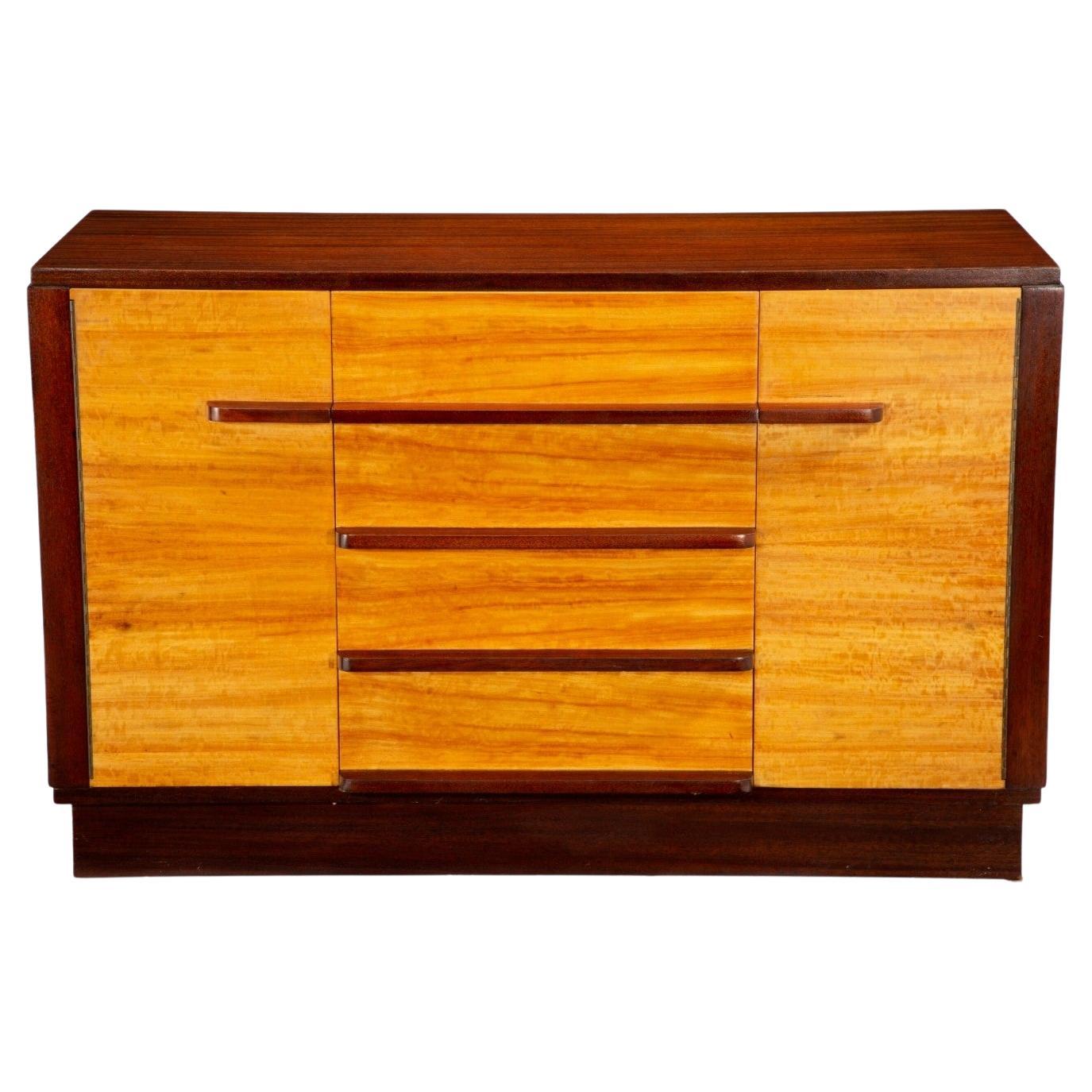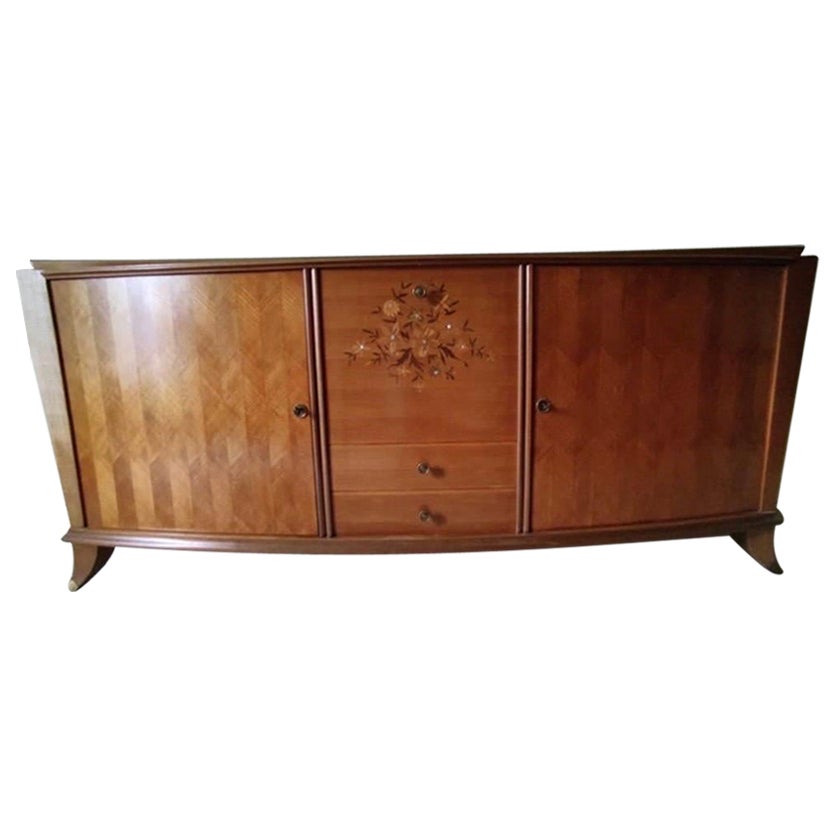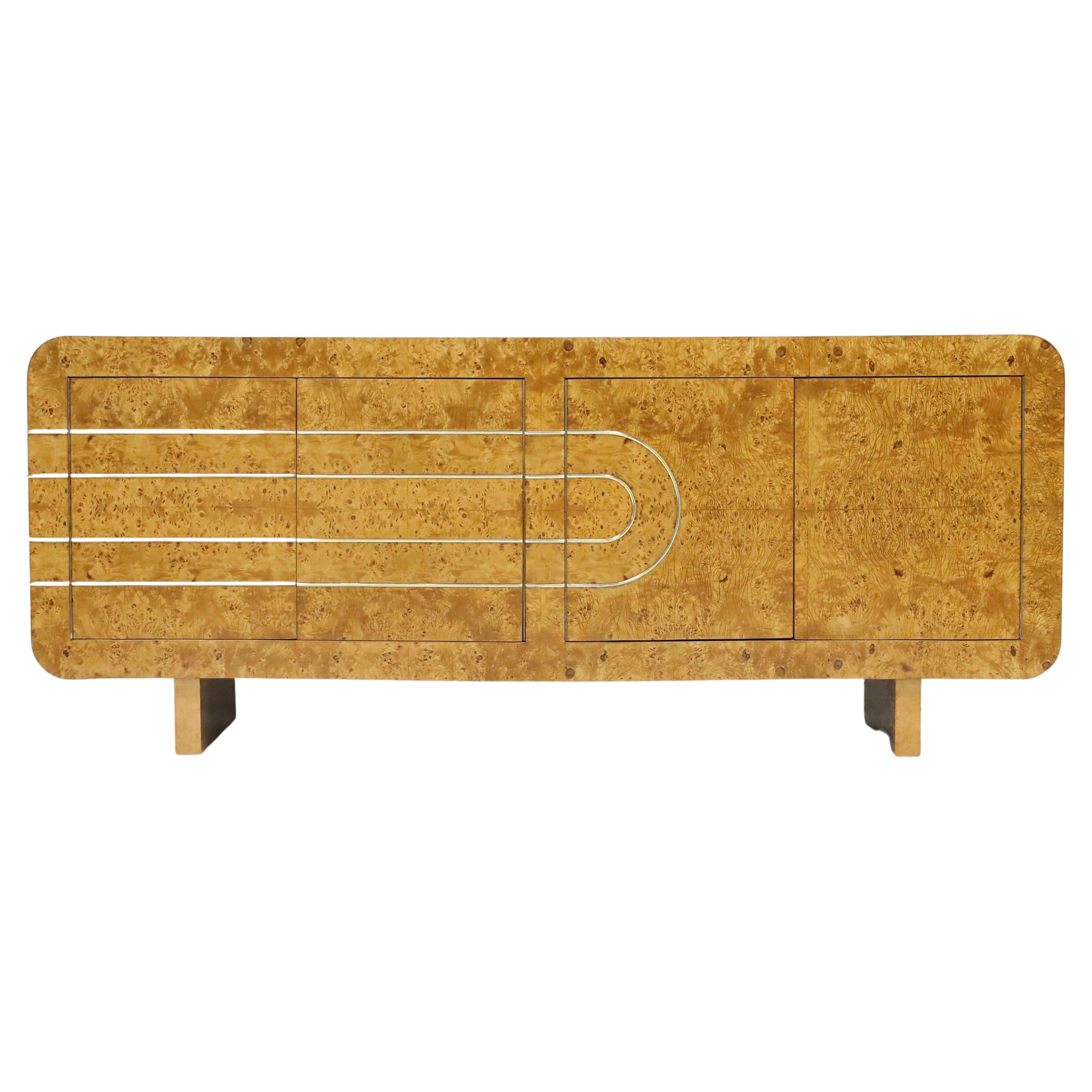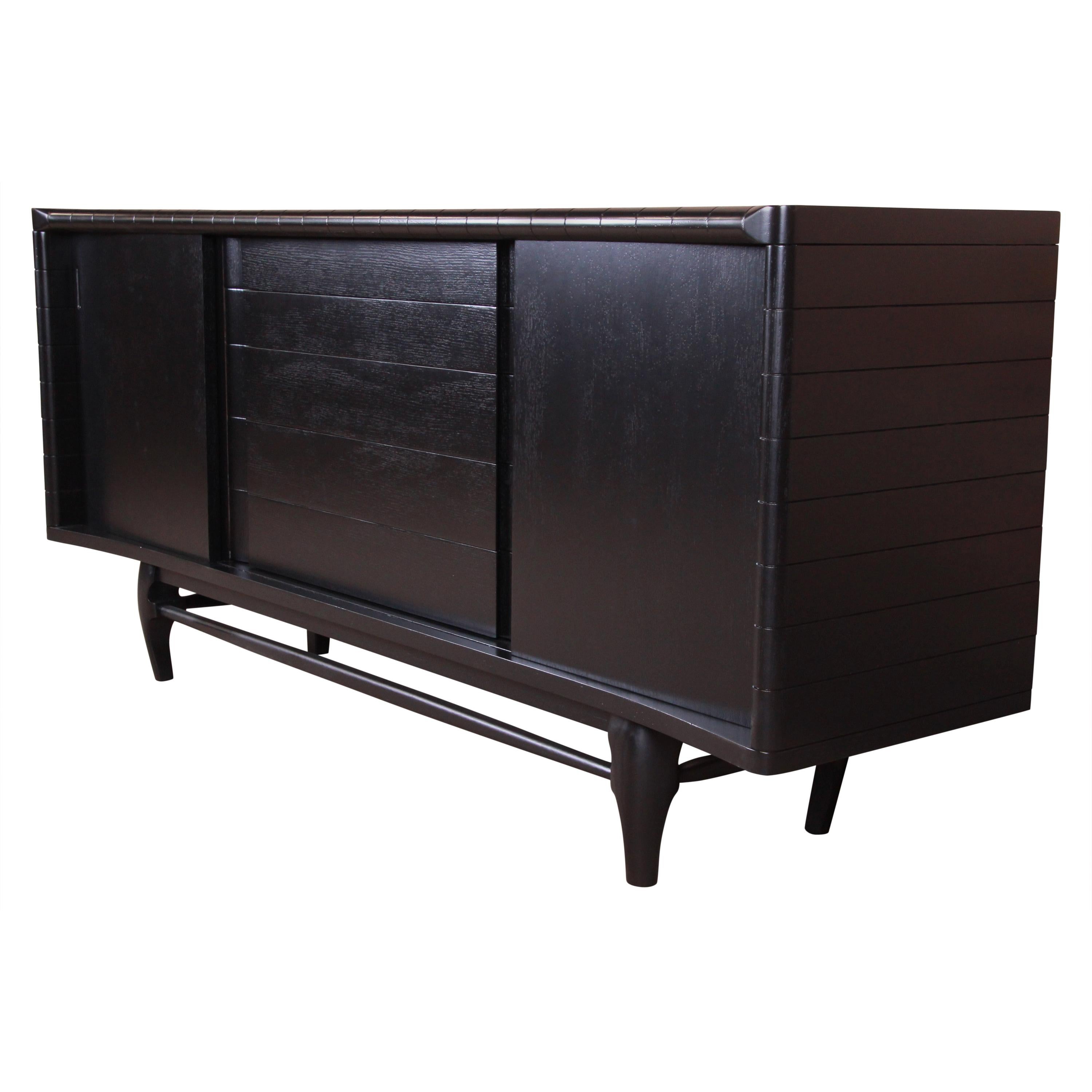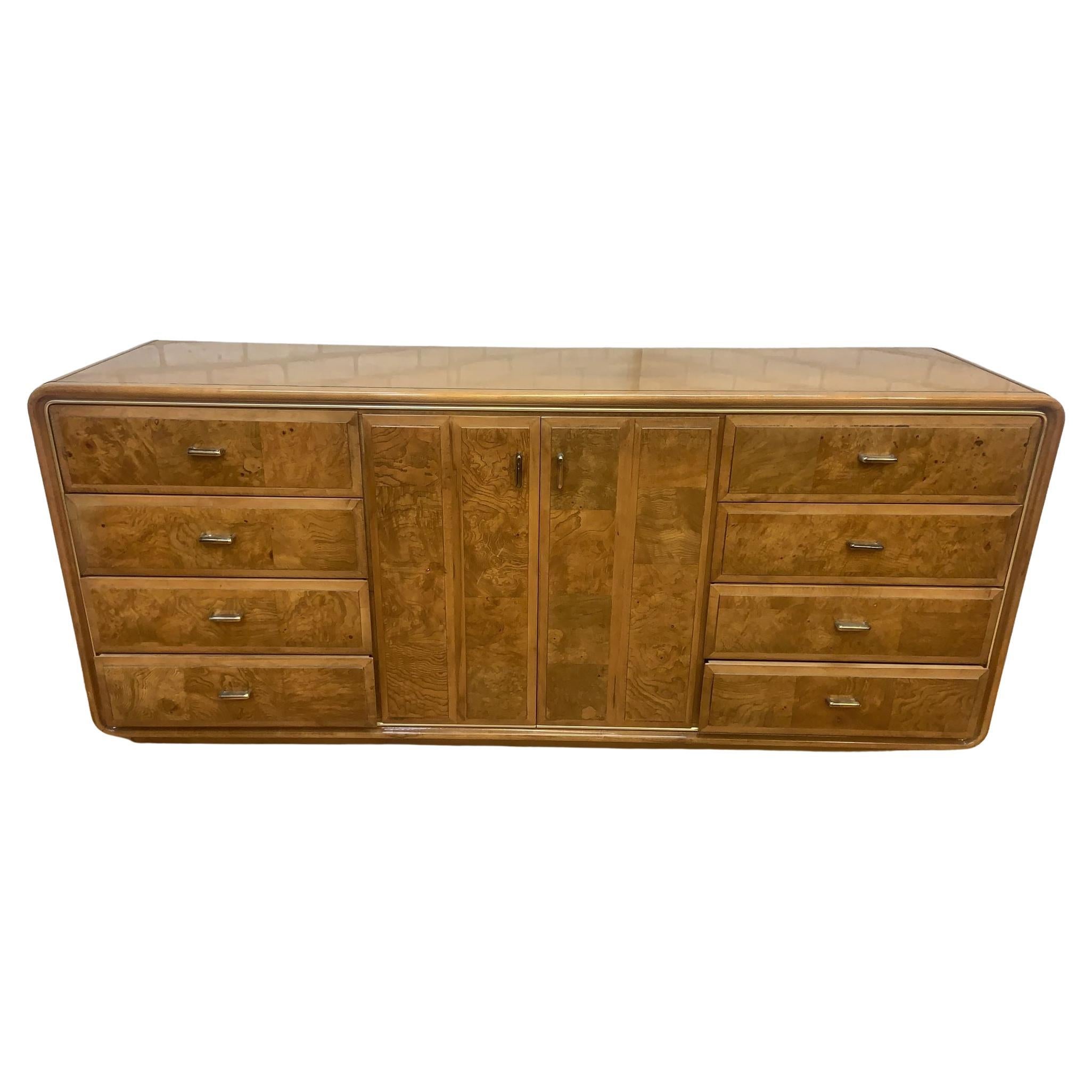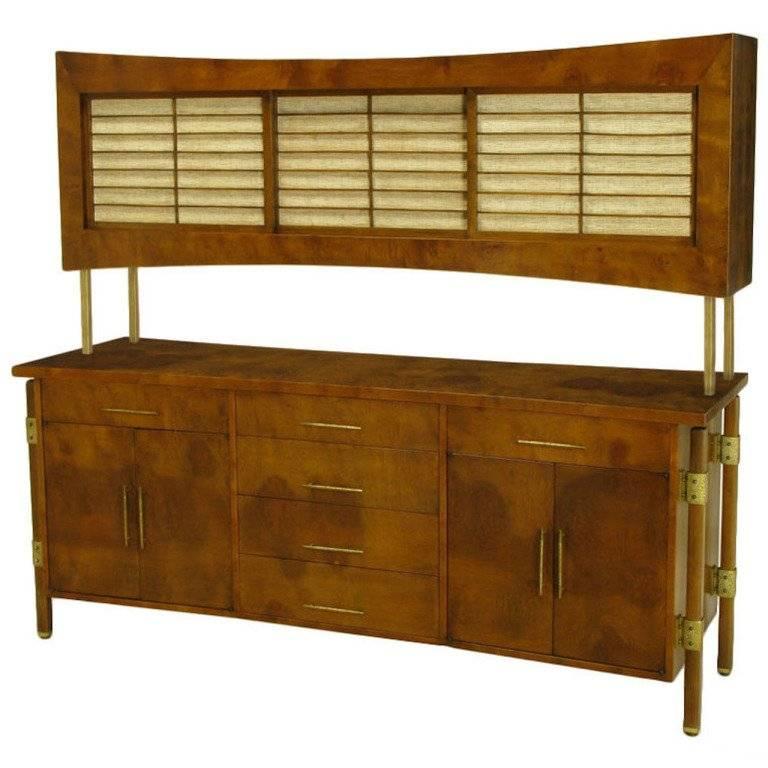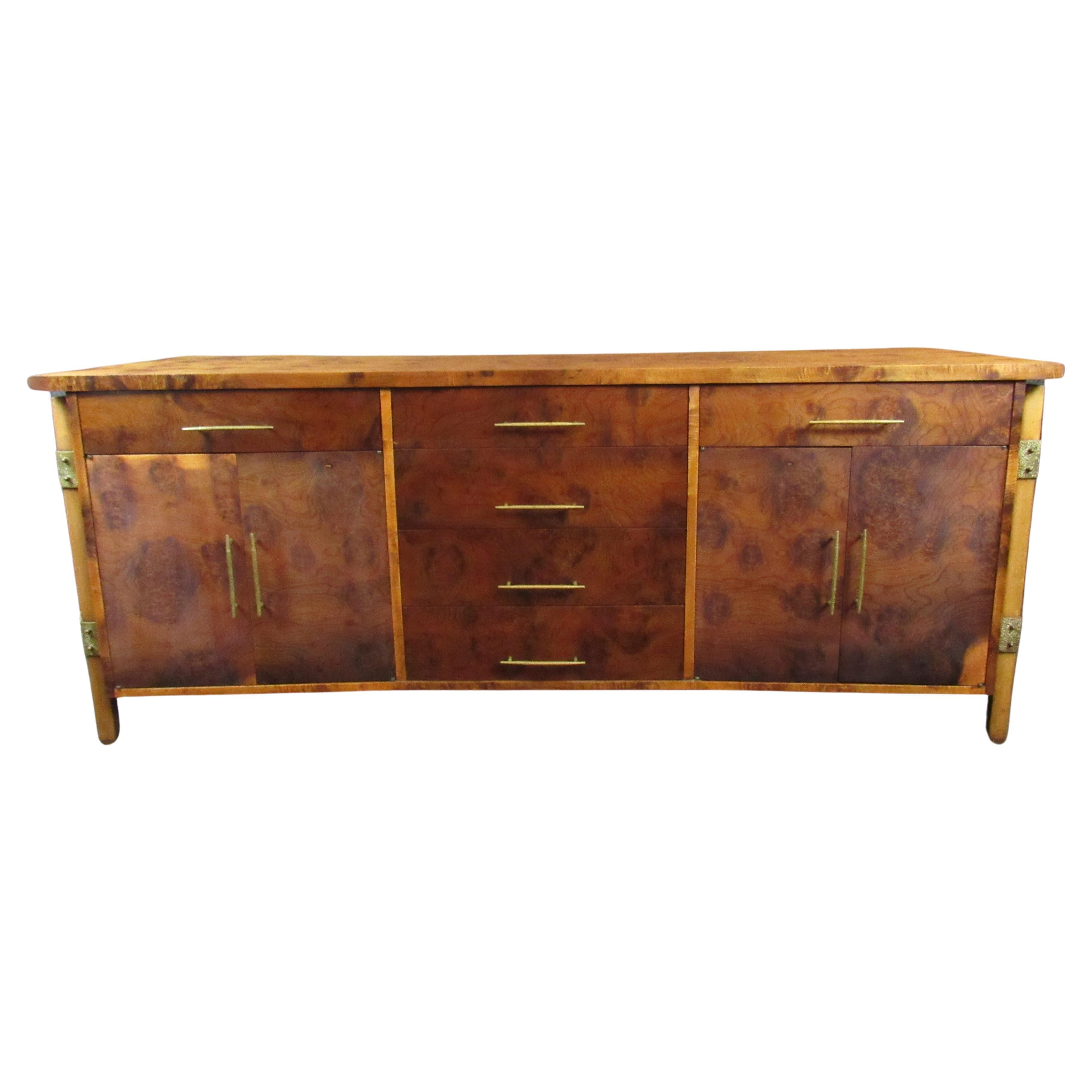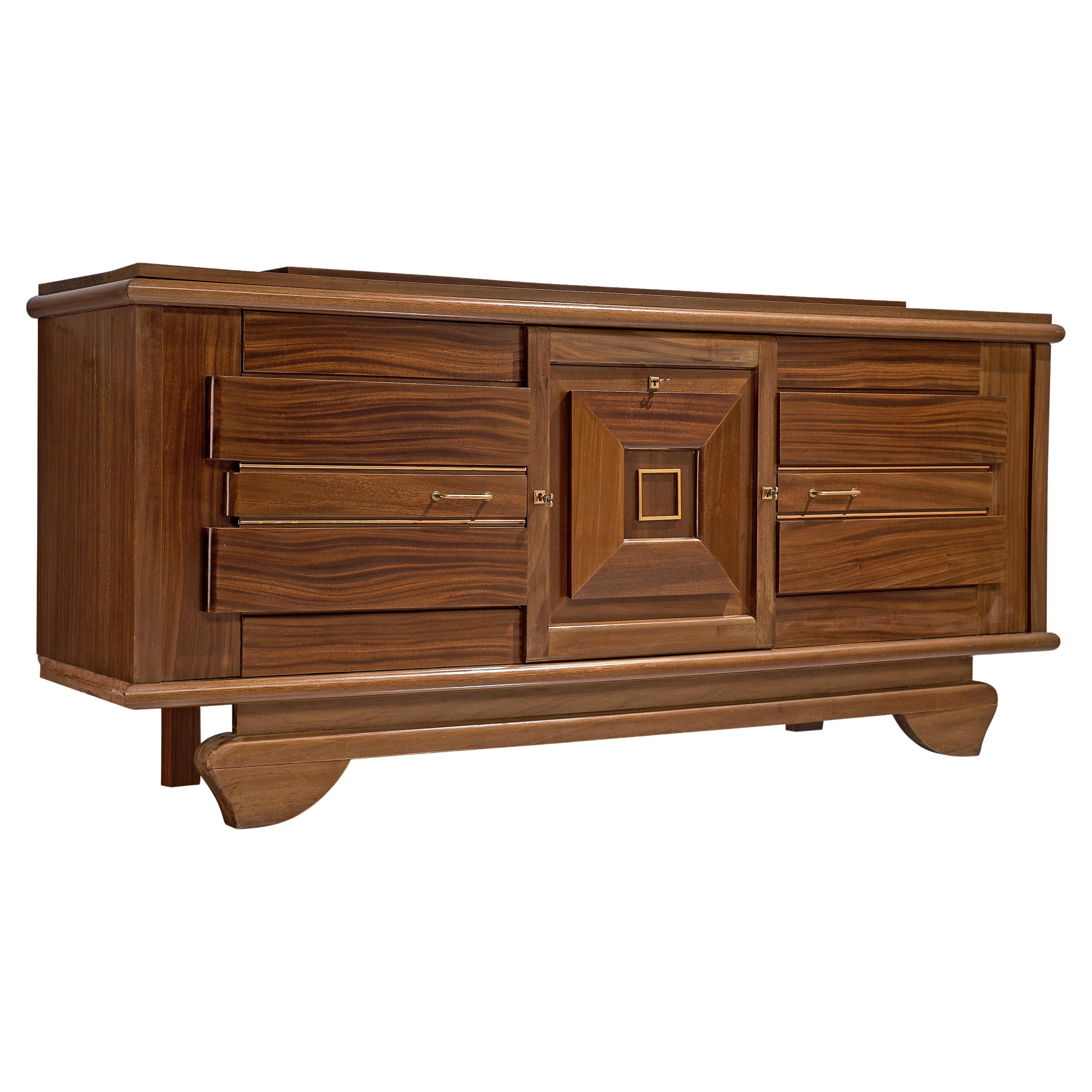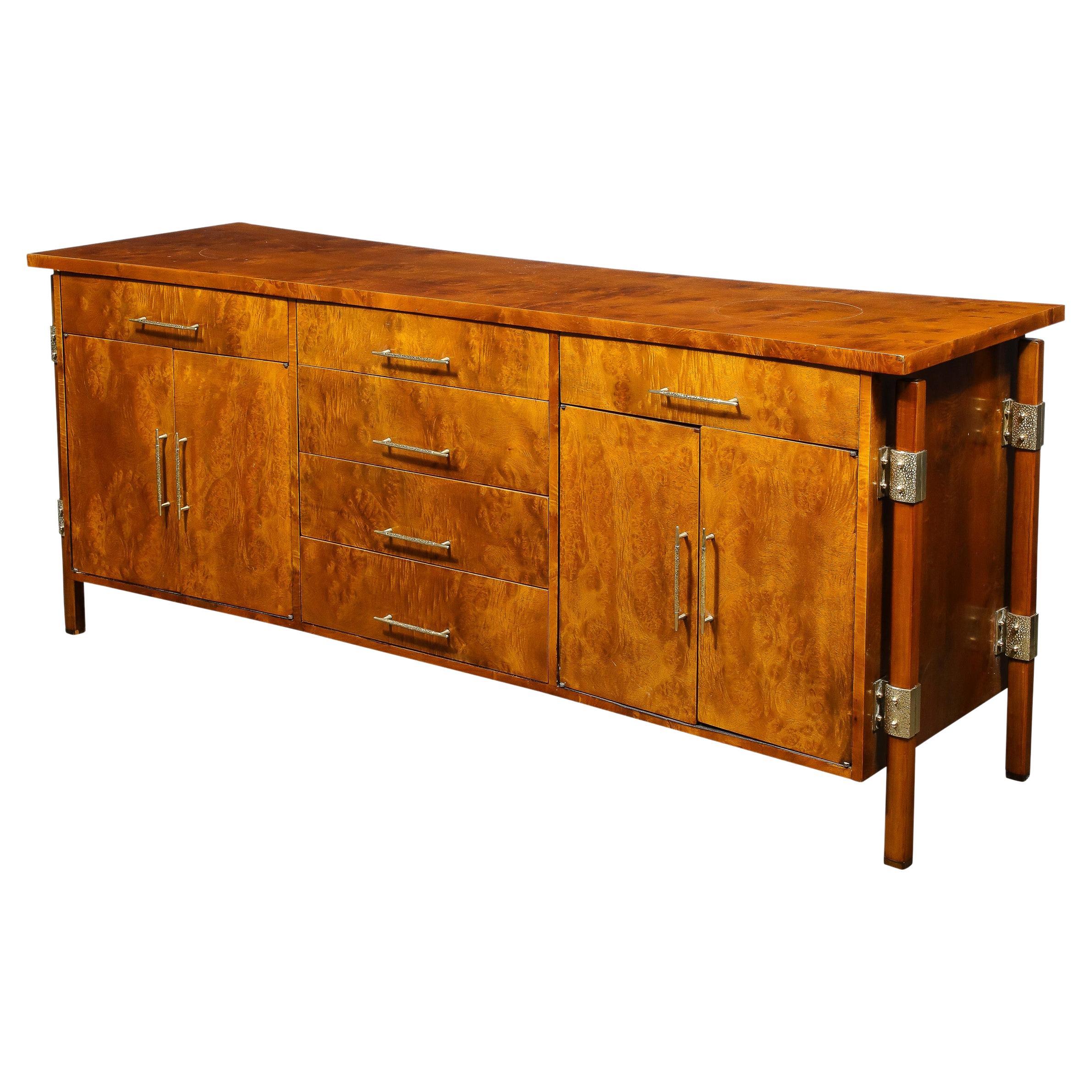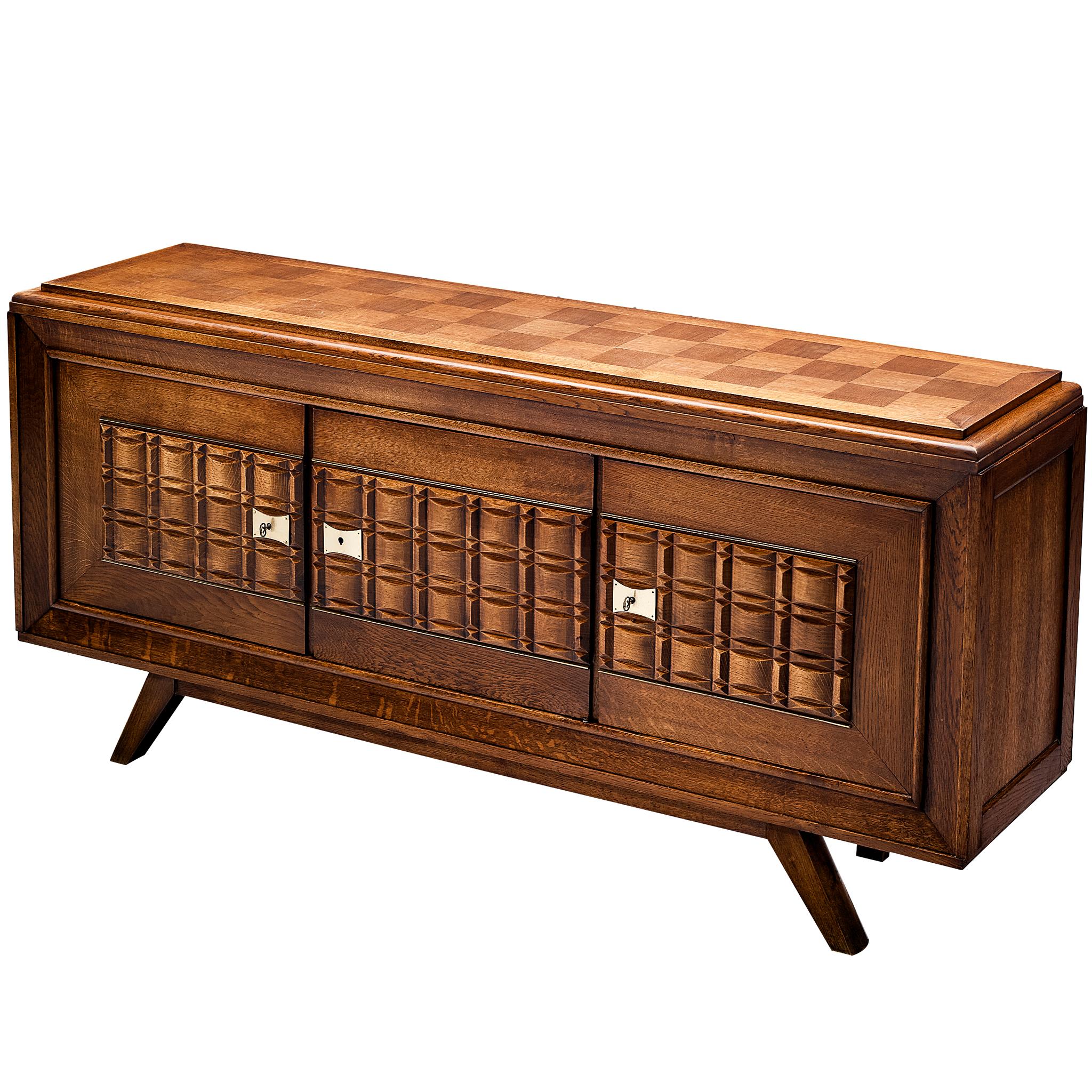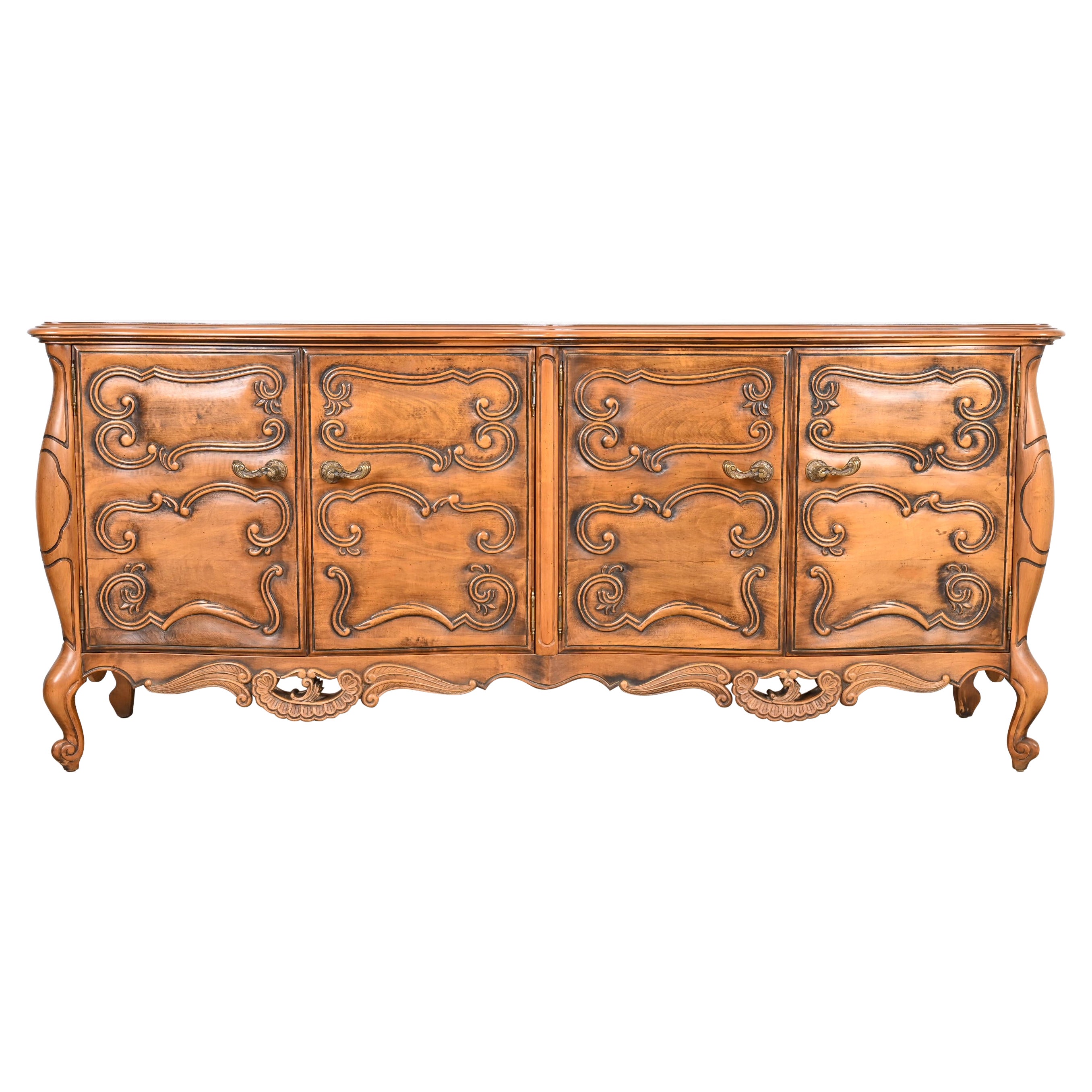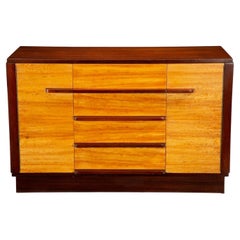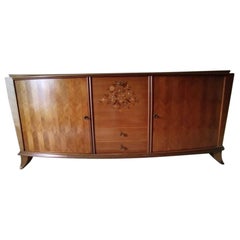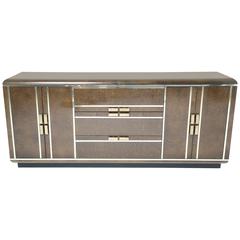
Romweber burlwood and brass sideboard in an art deco style.
View Similar Items
Romweber burlwood and brass sideboard in an art deco style.
About the Item
- Creator:Romweber Furniture Co. (Designer)
- Dimensions:Height: 30.32 in (77 cm)Width: 72.45 in (184 cm)Depth: 18.12 in (46 cm)
- Style:Mid-Century Modern (Of the Period)
- Materials and Techniques:
- Place of Origin:
- Period:
- Date of Manufacture:circa 1979
- Condition:Wear consistent with age and use.
- Seller Location:Oberstown, Lusk, IE
- Reference Number:1stDibs: LU108203502812
Romweber Furniture Co.
Some vintage Romweber Furniture Company designs may strike the young as passé. But for fans of a certain age, the American brand never went out of style.
The Romweber story began in the late 1800s, with the launch of American Furniture Company, which made bedroom furniture, Batesville Cabinet Company, a dining-room-set manufacturer, and Batesville Coffin Company. The three companies eventually merged to become a large and reputable manufacturer of case goods, furniture and more. Not unlike many American companies, production at Romweber suffered during the Great Depression. The brand managed to stay afloat by making a rather strange pivot — to selling five-pound fruitcake boxes. During the Second World War, Romweber pivoted again, this time to the production of ammunition boxes and pontoons for American troops and, naturally, furniture for officers’ quarters.
While Romweber furniture (spelled “RomWeber” in vintage advertisements), dating back to the early 20th century, had designers working in the French Rococo and Chippendale styles, the brand is best known for its mid-century modern pieces. In the postwar years, Romweber manufactured walnut case pieces and storage cabinets that featured decorative olive-ash and burl-wood inlays with brass hardware as well as solid oak credenzas and dining tables designed by the likes of Harold Schwartz. For collectors of sophisticated 1950s furniture, the company’s sturdy Viking Oak line is particularly popular.
“It’s not uncommon for customers to say, ‘My parents had this Romweber Viking set,’” says Adam Cramer of collectors who visit Liberty & 33rd, the gallery he owns with his wife in South Bend, Indiana, about three hours north of Romweber’s birthplace in small-town Batesville. “It’s solid oak,” Cramer tells 1stDibs of the line of tables, chairs, desks and more.
Solid oak is the product of slow-growing deciduous trees. Solid oak furniture is durable, desirable and an investment that is usually associated with a hefty price. In solid oak furnishings, such as those that make up the covetable Romweber Viking Oak line, which launched in 1935, there aren’t any scraps of other components in the construction. Inspired by Scandinavian folk design, Romweber’s Viking Oak is said to have enjoyed one of the longest runs for a commercial furniture line in history. The collection went out of production in the late 1980s, and mid-century editions remain highly prized for their exceptional quality and hand-carved details.
Find vintage Romweber furniture on 1stDibs.
- Art Deco Wolfgang Hoffmann Romweber World's Fair Century of Progress SideboardBy Wolfgang Hoffmann, Romweber Furniture Co.Located in Forney, TXA rare and important American Art Deco Century of Progress Sideboard by iconic designer Wolfgang Hoffmann (Austrian, 1900-1969) for Romweber Company, Batesville, Indiana. circa 1933-1936 Created for the 1933 Chicago World's Fair, fine quality craftsmanship and construction, having a rectangular exotic rosewood veneered top over conforming solid wood case fitted with four drawers affixed with horizontal pulls, the top drawer opening to reveal felt lined divided interior for silverware, flanked by cabinet doors opening to shelved interior, subtle geometric lines add interest. Rosewood, mahogany, richly figured blonde - golden birch or primavera. Signed, top drawer interior, featuring 1933 World's Fair mark impressed. **Please note, at the time of writing this, a matching display case - vitrine cabinet (shown in last photo) is currently available separately** Provenance / Acquisition: Property from the important and iconic Collection of Mr. James I. Rafftesaeth Jr., Dallas, Texas Acquired from highly reputable auction house, Heritage Auctions, Dallas, Texas. 2022 Design Signature Auction catalog #8091 History: Wolfgang Hoffmann was born in Vienna, Austria in 1900. He is the son of famous architect, pedagogue and Wiener Werkstatte cofounder, Joseph Hoffmann (1870-1956). Early on, following his father’s s interests, he was trained in the decorative arts and design. Wolfgang Hoffmann once reminisced, “I spent eight years at the Realschule, then three years went to a special architectural school, where I perfected my technical knowledge of architecture and general construction. From this school, I was graduated to the Kunstgewerbeschule [Studying under Oskar Strnad and Josef Frank in Vienna]. After finishing this school, I had one and a half years of practical in a well known architect’s office. Thereafter I worked in my Father’s office for two years”. Hoffmann met his future wife, Polish immigrant Pola (1902-1984) when they were both studying at the Kunstgewerbeschule. Joseph Urban (1872-1933) was needing an assistant for his architectural business in New York and contacted his friend and colleague, Joseph Hoffmann in Vienna. Hoffmann recommended his son Wolfgang. Urban hired him and sent a first class passage ticket to Vienna for Wolfgang to travel to New York. Wolfgang married Pola and traded his ticket for two tickets to America in steerage, arriving in New York City in December of 1925. Leaving the Urban office after nine months, Wolfgang and Pola formed an independent design practice with offices on Madison Avenue in Manhattan with the purpose of creating contemporary interiors and industrial designs. Early work included theaters, stores, and apartments mostly in New York City. During the late 1920’s and early 1930’s the Hoffmanns designed custom furniture for private clients. Some of these examples were shown in the February 1929 issue of House and Garden. Curiously, the examples’ design was attributed to Urban and the production to Pola Hoffmann, Inc. Established in the fall of 1928, the American Designers’ Gallery was “devoted exclusively to showing objects and interiors for practical use… by fourteen American architects and designers”. Its members included the Hoffmans and Urban as well as ceramist Henry Varnum Poor (1888-1971), architect Raymond Hood (1881-1934), artist designer Winold Reiss (1886-1953), graphic designer Lucien Bernhard (1896-1981), decorator Donald Deskey (1894-1989), and architect Ely Jacques Kahn (1884-1972). The Hoffmanns’ work was included in the American Designers’ Gallery’s two showcase events, its 1928 and 1929 exhibitions. Their dining alcove at the 1929 event featured a bench with a dinette table and two chairs in American walnut designed by Wolfgang and a rug by Pola. Lucien Bernhard, fellow Austrian immigrant who settled in New York a year before the Hoffmanns, operated the gallery and decorating service Contempora with Munich resident Bruno Paul (1874-1968). The Hoffmanns, occasionally participating with Contempora, designed a number of outstanding interiors, including the constructivist living room of 1930 for Mrs. O.R. Sommerich at 40 East 66th street. In 1934, Donald Deskey commissioned Wolfgang to design birchwood furnishings for the eclectic apartment at 625 Park Avenue belonging to Helena Rubinstein. In 1931, Wolfgang exhibited his work at the Pennsylvania Art Museum and the Museum of Modern Art in New York City. The same year, with Kem Weber (1889-1963) he organized the second and final exhibition of AUDAC- “Modern Industrial and Decorative Arts”- at the Brooklyn Museum. At this event, the Hoffmanns showed the dining room previously included in the American Designer’s Gallery’s 1929 exhibition in the Chase Bank Building lobby at 145 West 57th Street in Manhattan. In 1932 Wolfgang was asked to assist Urban in developing the color scheme for the 1933-34 Chicago World’s Fair “A Century of Progress”. He was also commissioned to design the interior and furniture for the fair’s lumber industries house. There he executed its living and dining rooms furnished by Kroehler Manufacturing Company of Chicago; the boys’ room by Shower Brothers...Category
Early 20th Century American Art Deco Sideboards
MaterialsBirch, Mahogany, Rosewood
- An art deco sideboardBy Jules LeleuLocated in Saint-Ouen, FRa 1930 sideboard in walnut inside in sycomore attributed to LeleuCategory
Mid-20th Century French Mid-Century Modern Sideboards
MaterialsWalnut
$5,382 - Vladimir Kagan Style Sideboard in Burlwood with Brass AccentsBy Vladimir KaganLocated in Dallas, TXThis is a gorgeous sideboard/dresser. We have fully restored to rediscover this beautiful burl wood finish. Curvilinear edges with an ultra thick band surround four doors. The trim i...Category
20th Century American Mid-Century Modern Sideboards
MaterialsMetal
- Harold Schwartz for Romweber Ebonized Sideboard Credenza, Newly RefinishedBy Harold Schwartz, Romweber Furniture Co.Located in South Bend, INAn exceptional Mid-Century Modern ebonized mahogany sideboard credenza or bar cabinet By Harold Schwartz for Romweber USA, 1950s M...Category
Vintage 1950s American Mid-Century Modern Sideboards
MaterialsMahogany
- Art Deco American of Martinsville Burlwood SideboardBy American of MartinsvilleLocated in Chicago, ILArt Deco American of Martinsville burlwood sideboard Stunning Art Deco American of Martinsville burlwood sideboard. Beautiful burlwood and brass ...Category
Vintage 1970s American Art Deco Sideboards
MaterialsGlass, Burl
- Rare Harold M. Schwartz for Romweber Burled Sideboard with Floating CabinetBy Harold Schwartz, Romweber Furniture Co.Located in Chicago, ILDesigned by Harold M. Schwartz for Romweber. Burled walnut side board with fiddle back highlights. Brutalist textured brass hardware, including brack...Category
Vintage 1950s American Mid-Century Modern Sideboards
MaterialsBrass
$9,375 Sale Price25% Off
